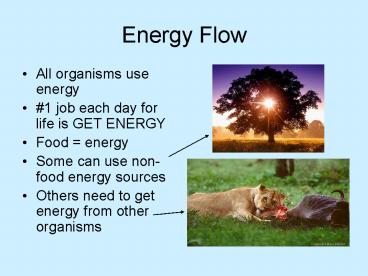Energy Flow - PowerPoint PPT Presentation
1 / 19
Title: Energy Flow
1
Energy Flow
- All organisms use energy
- 1 job each day for life is GET ENERGY
- Food energy
- Some can use non-food energy sources
- Others need to get energy from other organisms
2
- Organisms that can make their own food from
energy and inorganic materials are known as
producers or autotrophs - they produce organic molecules (carbohydrates,
proteins, etc.) from inorganic molecules
Chemosynthetic bacteria
Corn plants
3
Those producers that use the sun as their
energy source are known as photoautotrophs which
include plants, algae, some bacteria and many
single-celled organisms
4
Photosynthesis
- Photoautotrophs use a process called
photosynthesis to create organic molecules (food)
in which the sun is the energy source
Inorganic chemicals sunlight organic chemicals
Simple version
5
- Some deep-water bacteria, for example, are
producers without using sunlight - They produce organic molecules using inorganic
molecules and without sunlight - This is a process known as chemosynthesis
- this isnt a very common process most producers
use sunlight
Bacteria happily live here at 400 deg F and
pressures that would crush a submarine
6
Consumers
- Organisms that cannot make their own organic
molecules must eat other organisms and use theirs - Since they consume other creatures they are
known as consumers - some consumers eat dead organic matter they are
still considered consumers because they are
consuming already existing organic matter
7
Types of Consumers
- Herbivores feed exclusively on plant matter
- Ex. cardinals, bees, fruit bats, cows, certain
fish - Carnivores feed exclusively on animal tissue
- wolves, eagles, frogs, rattlesnakes, sharks,
spiders - Omnivores feed on both plant and animal matter
- Bears, humans, chimps, chickadees, crayfish
- Detritivores eat dead plant / animal matter
- Earthworms, crabs, some beetles, many insect
larvae - Decomposers same as above but digest food
outside - body and absorb
nutrients - MANY types of bacteria, any fungus
8
Energy Transfer
- Feeding is about 2 things
- Obtaining energy (1 reason)
- Obtaining organic molecules (amino acids,
nucleotides, etc) - Communities are structured mostly based on these
relationships - numbers of prey determine of predators
(different s depending on size of each) - Producers (their size and availability) are most
important
9
- Example wheat plant and 3 herbivores
10
(No Transcript)
11
(No Transcript)
12
Food Chains Webs
- A food chain is a particular pathway of energy
transfer in a community - Almost always begins with a producer
- May involve a series of consumers
- Each step in a food chain is called a trophic
level and energy is passed from one trophic level
to the next as organisms feed on those before
them in the chain
13
(No Transcript)
14
- The first consumer in a food chain is known as a
primary consumer (primary 1st) - This organism is usually an herbivore (may be an
omnivore) - The second is known as a secondary consumer and
may be either a (carnivore or omnivore) - Third consumer and beyond follow the same pattern
as the second
15
(No Transcript)
16
Food chains are limited in length. Why?
- Energy taken in by organisms at each trophic
level is used up - Used energy goes toward maintenance,
reproduction, growth, or is lost in wastes - On average, only about 10 of energy from each
trophic level gets passed on when an organism is
eaten
17
- Food chains only show 1 possible path of energy
flow - Food webs show many possibilities
- Shows better the true interrelationships within
the community -- everybody is connected
18
Ecological Pyramids
- Diagrams that show the numbers, biomass or energy
present at each trophic level in an ecosystem
Energy pyramid
19
Biomass Pyramid
Numbers Pyramid































